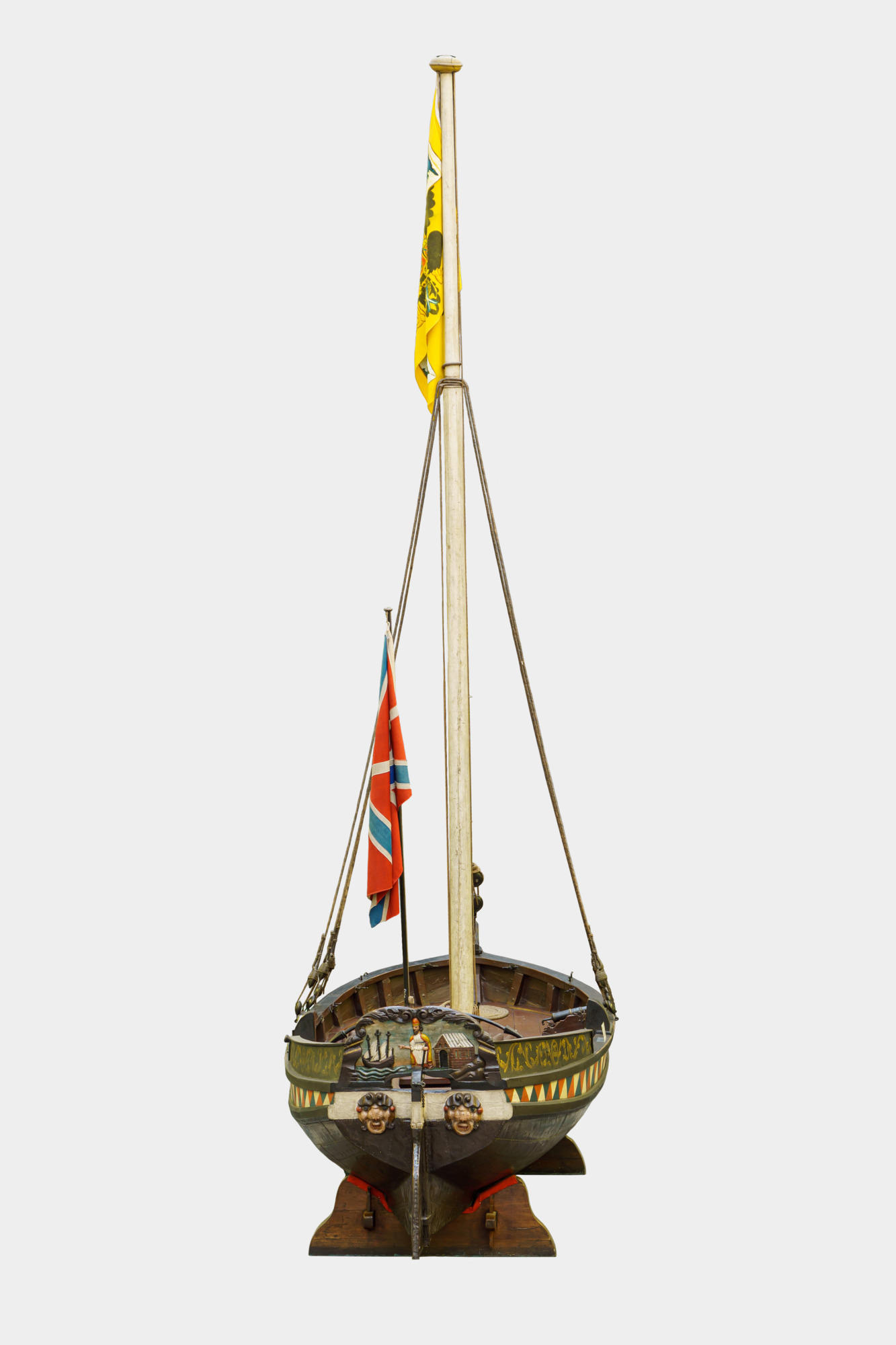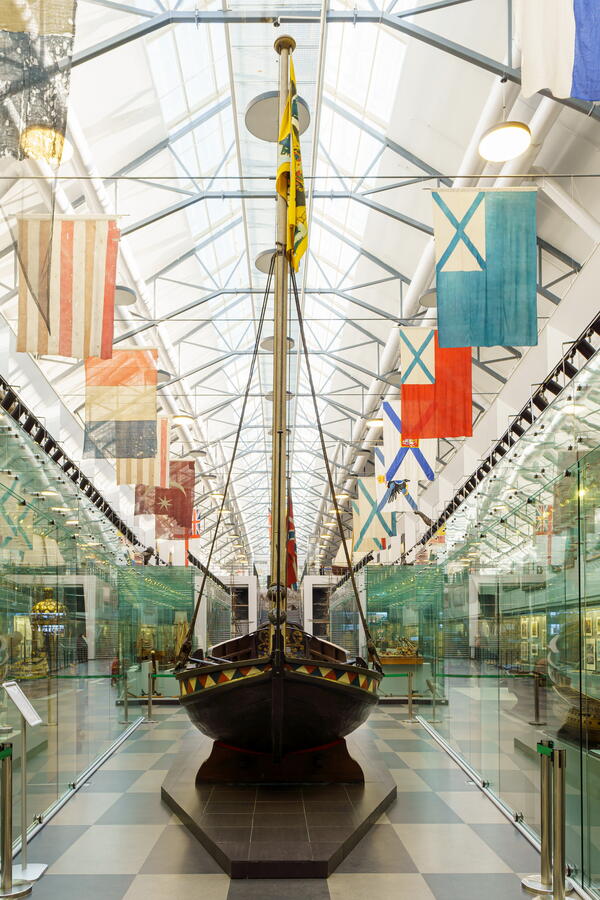The botik (small boat) was discovered by Peter the Great at the Royal Estate of Izmailovo, the residence of the House of Romanov, near Moscow. He found it while walking around the estate with his teacher, the Dutch shipbuilder Franz Timmerman, in May 1688.
In the early 1640s, the Russian tsar Mikhail Fyodorovich Romanov “ordered an extremely small boat <…> from England to be sent through Arkhangelsk to Moscow and named it ‘Saint Nicholas’.” Most likely, after the tsar’s death, the boat ended up in the shed of his cousin Nikita Ivanovich Romanov — a collector of “foreign curiosities”.
It was quite a unique ship that had a special hull shape, rigging, and painted boards and stern. The Dutch shipbuilder Karsten Brandt agreed to repair the boat that was moved to the Preobrazhenskoye village and to teach the art of sailing to Peter the Great. A shipyard was constructed at the place where the Trubezh River flows into Lake Pleshcheyevo, and a small flotilla was built at the shipyard. The Pereslavl Flotilla essentially became the first training corps of the future Russian Navy. The lessons learned by the tsar in the village near Moscow proved useful during the Azov campaign of 1696 and especially during the Great Northern War.
Peter the Great took certain measures to preserve the botik and venerate it as a national relic. In 1722, the emperor sailed the botik from Shlisselburg down the Neva to the Alexander Nevsky monastery in the new capital, Saint Peterburg, to bring it closer to the sea and the fleet. The boat was placed at the shipyard of the Admiralty. Anxious to protect the boat, Peter the Great instructed that it should be the first thing to be saved and set afloat in case of fire.
On August 11, 1723, “the botik was celebrated on the Kotlin Island” where it met the Baltic fleet. The festive dinner marked the first time that Peter the Great dubbed the old botik “the grandfather of the Russian navy”.
In 1767, it was transferred to a specially constructed pavilion known as the “Boathouse” where the vessel was kept for almost 170 years (nowadays, the building houses a full-size copy of the botik). By the early 1930s, the Boathouse was turned into a warehouse, while the botik was moved out as useless and placed by the employees of the Peterhof Palace Complex in a poultry run near the Monplaisir Palace. There, it was stored until September 1940 when it was donated as a national naval relic to the newly created Central Naval Museum housed in the former Stock Exchange building on the spit of Vasilyevsky Island in Leningrad. With the outbreak of the Great Patriotic War, the botik was evacuated to Ulyanovsk, and in March 1946, it was returned to the museum where it has enjoyed pride of place in the central hall ever since.
In the early 1640s, the Russian tsar Mikhail Fyodorovich Romanov “ordered an extremely small boat <…> from England to be sent through Arkhangelsk to Moscow and named it ‘Saint Nicholas’.” Most likely, after the tsar’s death, the boat ended up in the shed of his cousin Nikita Ivanovich Romanov — a collector of “foreign curiosities”.
It was quite a unique ship that had a special hull shape, rigging, and painted boards and stern. The Dutch shipbuilder Karsten Brandt agreed to repair the boat that was moved to the Preobrazhenskoye village and to teach the art of sailing to Peter the Great. A shipyard was constructed at the place where the Trubezh River flows into Lake Pleshcheyevo, and a small flotilla was built at the shipyard. The Pereslavl Flotilla essentially became the first training corps of the future Russian Navy. The lessons learned by the tsar in the village near Moscow proved useful during the Azov campaign of 1696 and especially during the Great Northern War.
Peter the Great took certain measures to preserve the botik and venerate it as a national relic. In 1722, the emperor sailed the botik from Shlisselburg down the Neva to the Alexander Nevsky monastery in the new capital, Saint Peterburg, to bring it closer to the sea and the fleet. The boat was placed at the shipyard of the Admiralty. Anxious to protect the boat, Peter the Great instructed that it should be the first thing to be saved and set afloat in case of fire.
On August 11, 1723, “the botik was celebrated on the Kotlin Island” where it met the Baltic fleet. The festive dinner marked the first time that Peter the Great dubbed the old botik “the grandfather of the Russian navy”.
In 1767, it was transferred to a specially constructed pavilion known as the “Boathouse” where the vessel was kept for almost 170 years (nowadays, the building houses a full-size copy of the botik). By the early 1930s, the Boathouse was turned into a warehouse, while the botik was moved out as useless and placed by the employees of the Peterhof Palace Complex in a poultry run near the Monplaisir Palace. There, it was stored until September 1940 when it was donated as a national naval relic to the newly created Central Naval Museum housed in the former Stock Exchange building on the spit of Vasilyevsky Island in Leningrad. With the outbreak of the Great Patriotic War, the botik was evacuated to Ulyanovsk, and in March 1946, it was returned to the museum where it has enjoyed pride of place in the central hall ever since.





